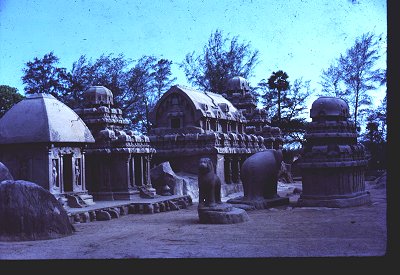Pallavas of Kanchi
by Jyotsna Kamat
First
Online: June 02, 2005
Page Last Updated: December 07, 2024
Pallavas of Kanchi (4th to 9th century CE)
Pallavas were a prominent dynasty that ruled South India for nearly 500 years and have left a permanent mark in the field of art and architecture. Their early history is difficult to construct for lack of inscriptional or literary evidence. Earlier it was believed that they were of foreign origin. (Pallava being derived from the word Parthia or Pehlavi). But now it is established they were very much a South Indian dynasty, and were earlier nobles of Satavahanas. They were followers of Vedic religion and later kings were great conquerors and builders. The famous shore-temples and rathas (chariots) of Mahabalipuram are their contribution.
Sivaskandhavarman who ruled in the first part of the fourth century CE was an independent ruler. He established his capital at Kanchi which continued as Pallava capital for centuries. He performed Ashwamedha sacrifice to establish as suzerain. More than sixteen kings ruled between 350 and 575 CE. Only from the famous Allahabad inscription of Samudragupta we learn that he defeated the Pallava king Vishnugopa.
Simhavishnu (560 - 580 CE) was a strong ruler who defeated Cholas, Pandyas and Kalabhras. They were all ancient dynasties ruling the southern region. Simhavishnu was a devotee of Vishnu. His and his queen's portrait is seen in stone at the Adivaraha temple of Mahabalipuram.
Mahendravaraman (600 - 630 CE) was a skillful ruler, poet and musician. Conflict with Chalukyas of Badami who ruled Deccan, started during his reign which continued for centuries. Earlier a Jaina by faith, he became a devotee of Lord Shiva later, under the influence of saint-poet Appar. A disciple of Rudracharya, a famous musician, Mahendra Varman was adept in playing veena. Mattavilasa prahasana a satirical play in Sanskrit on the hypocrisy of Kapalika and Buddhist sham monks is ascribed to him. Music, dance, art and architecture received a big boost during his reign. Paintings and frescoes of Sittanvassal belong to this period.
V.N. O'key/Kamat's Potpourri
Pavilions and Sculptures of Mahabalipuram
Narasimha Varman succeed him (630 - 668 CE). He defeated Pulakeshi II of Chalukyan dynasty who fell fighting. Pulikeshi himself was a great soldier and ruler who had defeated Harshavardhana the powerful monarch of Kanouj. Pallavas captured Badami which seems to have been under their siege for thirteen years. Narasimha varman also built strong navy and helped the king of Simhala (now Srilanka) to regain his lost kingdom. Kailasanatha temple at Kanchipuram and shore temple at Mahabalipuram were constructed during his reign.
Huen Tsang the Chinese monk-scholar who visited Kanchi in 642 CE, writes that the Pallava country was more than thousand miles in area and calls it Dravidanadu. Kanchi the capital was six miles wide. There were one hundred viharas and 10,000 Buddhist monks. There were magnificent basadis as well. Though the kings were of Brahmanical faith, they provided equal patronage to all religions as was the common trait with most of the rulers.
Darmapala, one of the greatest scholars of the time was president of Nalanda university and a guru of Huen Tsang. He hailed from Kanchi, attesting that Buddhism flourished in the Pallava capital.
Six more kings ruled thereafter. Pallavamalla Nandivarman's (730-800AD) accession deserves special mention. There was no direct descendant to succeed Parameshvaravarman. The subjects, officials and learned scholars of ghatika together elected Nandivaraman who was a descendant of Simhavishnu's brother. This account is given in a sculpted panel in the Vaikuntha Perumal temple of Kanchi. It also gives legendary origin of the Pallavas.
The reign of Rajasimha Naraimhavaraman II (700-728 CE) saw less of political conflicts. There was peace and prosperity. Arts and literature flourished. Dandin, Sanskrit writer was his court poet. Kailasnatha and Vaikuntha Perumal temple of Kanchi known for beautiful sculptures were extended during his period. Diplomatic and trade relations with China started from Rajasinha's reign.
Pallava, Pandya and Chalukya inscriptions throw different light on Nandivarman's reign. Chalukya Vikramadity II was in Kanchi and gave a huge grant to Kailasnath temple there. There is a Kannada inscription on one of the pillars of the temple. This king returned to Badami taking with him rare jewels and elephants.
Rise of Rashtrakutas saw the decline of Pallavas. Though they were related by marriage, conflicts continued. It was Vijayalaya the Chola king, who completely vanquished Aparajitavarma the last Pallava king in 890 AD.
![]()
See Also:
- Pallava Art & Architecture -- Article on the art and architecture of South India during the rule of the Pallava kings.

